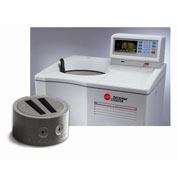The ProteomeLab XL-A/XL-I in-solution characterization of proteins,
oligomers, aggregates, particles, colloids, and small structures
delivers accurate results you can rely on time and again. In-solution
characterization allows for testing in native conditions, meaning you
determine the sample testing environment that best suits your needs. The
unique column-free separating technique of the ProteomeLab XL-A/XL-I
measures the relative change in the distribution of molecular weights,
providing an efficient way to measure heterogeneity, stoichiometry and
self-associating systems. And, because the measurements are based on the
first principles of thermodynamics and hydrodynamics, no standards or
calibrations are required. As a result, you spend less time on setup and
more time on discovery.
Our analytical ultracentrifuge platform
offers a variety of customizable options, to meet your needs. Sensitive
absorbance optics enable analysis of most samples, and interference
optics can be used for low concentrations. Both systems can be
implemented simultaneously, to maximize data acquisition in a single
run. Additionally, we offer two different rotor configurations, and a
variety of cell types, to enable multiple experimental designs. The
wide range of rotational velocities also allow investigators to probe
protein size, dimerization, and binding constants.
As mentioned, the
analytical ultracentrifuge can be used for several types of experiments,
but the two most widely used are sedimentation velocity and
sedimentation equilibrium. Sedimentation velocity experiments are
utilized to determine protein molecular weight and identify degree of
dimerization. In a sedimentation velocity experiment, high rotor speeds
are used to completely sediment all particles in solution. Protein
dimers sediment at a different rate than single protein molecules owing
to their higher weight, and since the analytical ultracentrifuge
measures protein formulations in their native state, the degree of
dimerization can be assessed to highly accurate levels.
Sedimentation
equilibrium experiments use lower velocity, and assess the
concentration distribution as a function of g-force applied. By
measuring the concentration curve at several different g-forces,
equilibrium binding constants can be measured. This approach provides
several advantages to alternative technologies, which often require
immobilization of one binding partner, and thus, can impact equilibrium
binding by modify the conformation of the immobilized protein.
The
analytical ultracentrifuge can also be used for high resolution size
analysis of particles, and has been applied to samples as diverse as
quantum dots, polymer nanoparticles, and carbon nanotubes. Since the
instrument performs both separation and detection in a single
experiment, it provides many advantages over ensemble techniques such as
light scattering. Mass proportional size distributions can be
obtained, which cannot be measured with ensemble approaches.
Beckman
Coulter pioneered the field of analytical ultracentrifugation, with the
first commercial model, and has continued to supply the field with high
quality, powerful, and reliable instrumentation for several decades.
Our current instruments continue this history of innovation, and are
relied upon by academic and industrial customers throughout the world.
FEATURES:
The
ProteomeLab XL-A is configured with a scanning UV/Vis detection system
that provides sensitivity for low-concentration work and selectivity for
optimizing detection based on the sample's maximum absorbance. The
addition of Rayleigh Interference Optics provides the capability to
measure the change in refractive index resulting from changes in sample
concentration. This delivers increased accuracy and the ability to
examine a greater concentration range with a wider selection of samples.
The XL-I can collect data from both detection systems sequentially, to
provide the broadest spectrum of data for protein characterization in
solution.
For
easy sample preparation, inject as little as 15µL to 120µL of sample
and reference solutions into opposing positions in the cell assembly,
and place the assembly into the system. Up to 28 different
sample/reference pairs can be studied in a single run, with each having a
different set of solute/solvent conditions (pH, ionic strength,
concentration). This provides data for accurate analysis in as little as
three hours. Your sample can be retrieved for additional analysis.
A
pre-assembled cell features a flow-through centerpiece that saves you
time. Sample and reference solutions can be directly injected in the
cell and retrieved for additional analysis without assembling or
disassembling the cell. A second hole above each channel allows the cell
to be cleaned and rinsed (with tubing and syringe) and ready for the
next run.
SPECIFICATIONS:
| UNSPSC: | 41103900 |
| Height: | 120.7 cm (47.5 in.) |
| Width: | 94.0 cm (37 in.) |
| Depth: | 67.3 cm (26.5 in) |
| Weight: | 465 Kg (1025 lb) |
Availability of rotors, parts and accessories.
